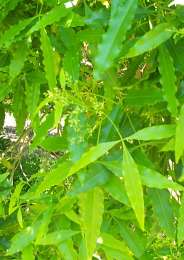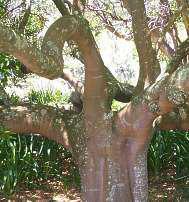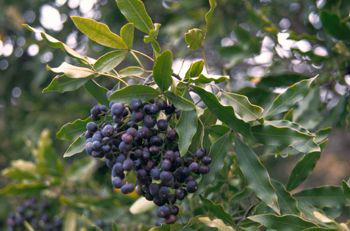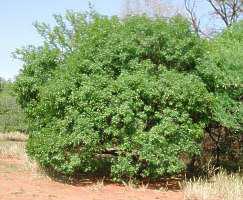Vepris lanceolata
Vepris lanceolata (Lam.) G.Don
Family: Rutaceae
Common names: white ironwood (Eng.); witysterhout (Afr.); Muruvula (Tsonga); Muhondwa (Venda); umZane (Xhosa); umOzana (Zulu)
SA Tree No: 261
Introduction
What a lovely, underrated shrub or tree-a plant that South Africans can definitely try in their gardens in the future!

Description
Description
The white ironwood is mostly an evergreen shrub or small tree of up to 5 m in height, but can reach a height of 20 m in dry forest areas. The bark is smooth and grey to dark grey in colour.

The leaves are trifoliolate, leathery, alternately arranged on the stem, and hairless. The leaflets are narrowly elliptic in shape, with the margins entire and markedly wavy; the apex tapers to a more or less rounded point. As the plant belongs to the Rutaceae family, the leaves are densely covered with gland-dots and have a lemony scent when crushed.
The flowers are small, inconspicuous, star-shaped and arranged in terminal heads or panicles and are greenish yellow in colour. The male and female flowers are borne on different trees. The white ironwood flowers from December to March.

The globose, 4-locular fruit of about 5 mm in diameter is covered by a smooth, thin, fleshy cover that turns black when ripe. The fruit is covered with gland-dots that have the same lemony scent as the leaves. The fruit ripens from May to July.
The wood is hard, heavy, strong, elastic and even-grained with a whitish to pale yellow colour.

Distribution and habitat
Distribution description
This lovely plant occurs in dune, riverine and low-lying forest along the coast from the Western Cape, through Eastern Cape to Kwazulu-Natal and the woodland and escarpment forests in Mpumalanga, Limpopo, the northern section of Gauteng and the northeastern section of the North-West Province.
Derivation of name and historical aspects
History
The most noteworthy members of this family are the buchus ( Agathosma species) that occur in the Cape and are used medicinally and in the well-known buchu brandy. The generic name Vepris originated from the Latin word vepres meaning a bramble or thorny shrub. The word lanceolata refers to the shape of the leaflets.
Ecology
Ecology
According to Thomas & Grant (2004), three different species of caterpillars of the Swallowtail butterfly family feed on this tree and the best known of the species is the Citrus Swallowtail butterfly, Papilio demodocus. It is also reported that porcupines eat the bark and ultimately ring-bark the trees, causing them to die. A number of bird species have been noted to love the fruits, such as the Redwinged Starling and the Crested Barbet. Bees feed on the flowers.

Uses
Use
Traditionally the powdered roots are used for influenza and colic and the leaves are burnt to dispel evil spirits. The wood is used to produce wheel spokes, handles, roof beams, furniture, ornaments and turnery.

Growing Vepris lanceolata
Grow
Vepris lanceolata makes an excellent garden subject and can be grown from seed; the young plants transplant well. It can tolerate some frost and can survive occasional drought, but does not flourish in very dry areas. The tree grows reasonably fast and does not have a very aggressive root system. It can be pruned in different shapes and makes a good container plant.
References
- Coates Palgrave, M. 2002. Keith Coates Palgrave Trees of southern Africa , edn 3. Struik, Cape Town.
- Jackson, W.P.U. 1990. Origins and meanings of names of South African plant genera . University of Cape Town Ecolab, Rondebosch.
- Thomas, V. & Grant, R. 2004. SAPPI tree spotting, Kwazulu-Natal and Eastern Cape . Jacana, Johannesburg.
- Van Wyk, B. & Van Wyk, P. 1997. Field guide to trees of southern Africa. Struik, Cape Town.
- Van Wyk, B.,Van Wyk, P. & Van Wyk, B-E. 2000. Photographic guide to the trees of southern Africa. Briza Publications, Pretoria.
Credits
Karin Behr
Pretoria National Botanical Garden
November 2004
Plant Attributes:
Plant Type: Tree
SA Distribution: Eastern Cape, KwaZulu-Natal, Limpopo, Mpumalanga, Western Cape
Soil type: Sandy, Loam
Flowering season: Late Summer, Autumn
PH: Acid, Alkaline, Neutral
Flower colour: Green, Cream
Aspect: Full Sun, Shade, Morning Sun (Semi Shade), Afternoon Sun (Semi Shade)
Gardening skill: Average
Special Features:
Horticultural zones










Rate this article
Article well written and informative
Rate this plant
Is this an interesting plant?
Login to add your Comment
Back to topNot registered yet? Click here to register.